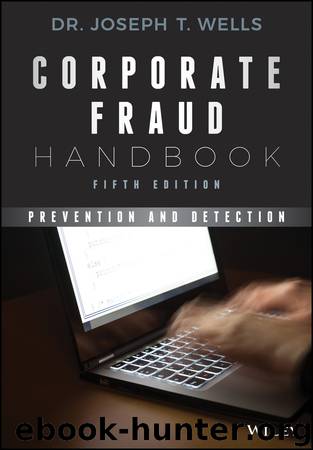Corporate Fraud Handbook by Joseph T. Wells

Author:Joseph T. Wells
Language: eng
Format: epub
ISBN: 9781119351955
Publisher: Wiley
Published: 2017-05-01T00:00:00+00:00
The false expense report induces the victim company to issue a payment to reimburse the perpetrator for personal expenses. A mischaracterization is a simple scheme, amounting to little more than fibbing. In cases involving airfare and overnight travel, a mischaracterization scheme sometimes can be detected simply by comparing the employee's expense reports to her work schedule. Often the dates of the so‐called business trip coincide with a vacation or day off. Detailed expense reports allow a company to make this kind of comparison and therefore are very helpful in preventing expenses schemes.
Requiring detailed information means more than just supporting documents; it should mean precise statements of what was purchased, as well as when and where. In one case, a fraudster submitted credit card statements as support for expenses but submitted only the top portion of the statements, not the portion that describes what was purchased. Over 95 percent of his reimbursed expenses were of a personal rather than a business nature. Of course, in this particular example, the scheme was made easier because the perpetrator was the chief executive of the company, which made it unlikely that anyone would challenge the validity of his expense reports.
Interestingly, many of the mischaracterized expense schemes in our studies were undertaken by high‐level employees, owners, or officers. Many times, such a perpetrator actually has authority over the account from which expenses were reimbursed. In other cases, perpetrators simply fail to submit detailed expense reports or even any expense reports at all. Obviously, when a company is willing to reimburse employee expenses without any verifying documentation, it is easy for employees to take advantage of the system. Nevertheless, there does not seem to be anything inherent in the nature of a mischaracterization scheme that would preclude its use in a system in which detailed reports are required. As an example, suppose a traveling salesman goes on a trip and runs up a large bar bill one night in his hotel, saves his receipt, and lists this expense as “business entertainment” on an expense report. Nothing about the time, date, or nature of the expense would readily point to fraud, and the receipt would appear to substantiate the expense. Short of contacting the client who was allegedly entertained, there is little hope of identifying the expense as fraudulent.
One final note is that mischaracterization schemes can be extremely costly. They do not always deal with a free lunch here or there but instead may involve very large sums of money. In one example, two mid‐level managers ran up $1 million in inappropriate expenses over a two‐year period. Their travel was not properly overseen and their expense requests were not closely reviewed, allowing them to spend large amounts of company money on international travel, lavish entertainment of friends, and the purchase of expensive gifts. They simply claimed that they incurred these expenses entertaining corporate clients. Though this case was costlier than the average mischaracterization scheme, it underscores the potential harm that can occur if the reimbursement process is not carefully attended to.
Download
This site does not store any files on its server. We only index and link to content provided by other sites. Please contact the content providers to delete copyright contents if any and email us, we'll remove relevant links or contents immediately.
Zero to IPO: Over $1 Trillion of Actionable Advice from the World's Most Successful Entrepreneurs by Frederic Kerrest(4048)
Machine Learning at Scale with H2O by Gregory Keys | David Whiting(3618)
Harry Potter and the Goblet Of Fire by J.K. Rowling(3608)
Never by Ken Follett(3523)
Ogilvy on Advertising by David Ogilvy(3327)
Shadow of Night by Deborah Harkness(3173)
The Man Who Died Twice by Richard Osman(2807)
Book of Life by Deborah Harkness(2717)
My Brilliant Friend by Elena Ferrante(2698)
How Proust Can Change Your Life by Alain De Botton(2613)
0041152001443424520 .pdf by Unknown(2592)
Will by Will Smith(2577)
The Tipping Point by Malcolm Gladwell(2556)
How to Pay Zero Taxes, 2018 by Jeff A. Schnepper(2499)
Purple Hibiscus by Chimamanda Ngozi Adichie(2481)
Hooked: A Dark, Contemporary Romance (Never After Series) by Emily McIntire(2416)
Rationality by Steven Pinker(2148)
Borders by unknow(2116)
Daughter of Smoke and Bone by Laini Taylor(2077)
